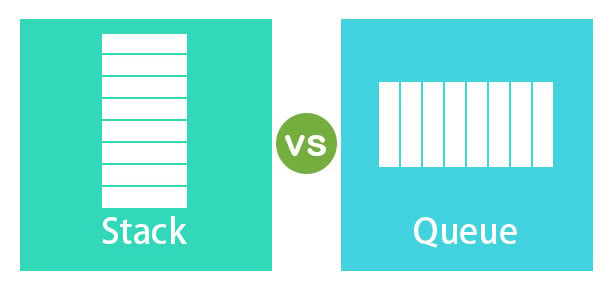Updated March 27, 2023

Difference Between Stack and Queue
Stack and Queue are one of the most commonly used linear data structures. The stack is an abstract data type which is used commonly in one or more programming language. The stack is a LIFO (Last in First Out) data structure which means an element that is inserted last will be accessed first in the stack. On the other hand, the queue is also an abstract data type and linear data structure, which is based on FIFO (First in First Out), which means an element inserted first will be accessed first in the queue. In this article, we will discuss the top differences between stack vs queue in detail.
Head to Head Comparison Between Stack and Queue (Infographics)
Below are the top 11 differences between Stack vs Queue:
Key Differences Between Stack and Queue
The following are key points of difference between stack and queue:
- The stack is a linear data structure in which elements are inserted and deleted from only one end called top and is based on LIFO (Last in First Out) principle, which means an element inserted last will be removed first. On the other hand, Queue is also a linear data structure in which elements are inserted from one end called a rear end and deleted from the other end called the front end. Unlike stack, the queue is based on FIFO (First In First Out) principle, which means elements inserted first are removed first.
- Insert operation is stack is called a push, whereas insert operation in the queue is called enqueue.
- Delete operation is stack is called pop whereas delete operation in the queue is called dequeue.
- In the stack’s case, only one pointer is maintained, whereas, in the queue, we require two pointers.
- The stack data structure is a recursive data structure and is used in solving problems based on recursion, whereas queue is a sequential data structure and is used to solve problems involving sequential processing.
- The stack can be used to solve problems like pre-order, post-order and in-order traversal of the binary tree, which are based on recursion, whereas queue can be used to solve problems like producer-consumer problem involving sequential processing of underlying data.
- The stack data structure can be used to solve problems like reversing a string, whereas the queue can be used to implement a blocking queue that ensures thread safety.
- Stacks are seen as a vertical linear collection, whereas queue can be seen as a horizontal linear collection of elements.
- The collection of plates placed one over the other is a real-world example of a stack, whereas people standing in a queue to pay an electricity bill is a real-world example of the queue.
Stack vs Queue Comparison Table
Here is a comparison table showing similarities between stack and queue:
|
Stack |
Queue |
| The stack is an abstract data type and linear data structure. | The queue is also an abstract data type and a linear data structure. |
| The stack is implemented on top of basic data structures like an array or linked list. | The queue is also implemented on top of basic data structures like an array or linked list. |
| The stack is a linear data structure in which elements are inserted and deleted from only one end called top and is based on LIFO (Last in First Out) principle. | The queue is a linear data structure in which elements are inserted from one end called a rear end and deleted from the other end called the front end and is based on FIFO (First In First Out) principle. |
| Insertion and deletion of elements take place from only one end in the stack. | Insertion and deletion of elements are carried out from different ends in the queue. |
| Insert operation is stack is called Push. | Insert operation in the queue is called enqueue. |
| Delete operation is stack is called Pop. | Delete operation in the queue is called dequeue. |
| Only one pointer is maintained in the Stack data structure, which is pointing to the top element of the stack. | Queue data structure requires maintaining two pointers, pointing to the rear end and pointing to the front end. |
| The stack data structure is a recursive data structure and is used in solving problems based on recursion. | The queue is a sequential data structure and is used to solve problems involving sequential processing. |
| The stack can be used to solve problems like pre-order, post-order and in-order traversal of a binary tree. | Producer consumer problems are solved using a queue as the underlying data structure. |
| Stacks can be considered as a vertical linear collection. | The queue can be considered as a horizontal linear collection. |
| The collection of plates placed one over the other is a real-world example of the stack. | People standing in a queue to pay the electricity bill is a real-world example of a queue. |
Conclusion
Both the above-mentioned stack and queue are non-primitive abstract data structures that are defined as a collection of elements organized in order but based on different operating principles. Both stack and queue are very important data structures as they both can be utilized efficiently in different conditions.
Recommended Articles
This is a guide to Stack vs Queue. Here we discuss the top key differences with infographics and comparison table. You may also have a look at the following articles to learn more –

